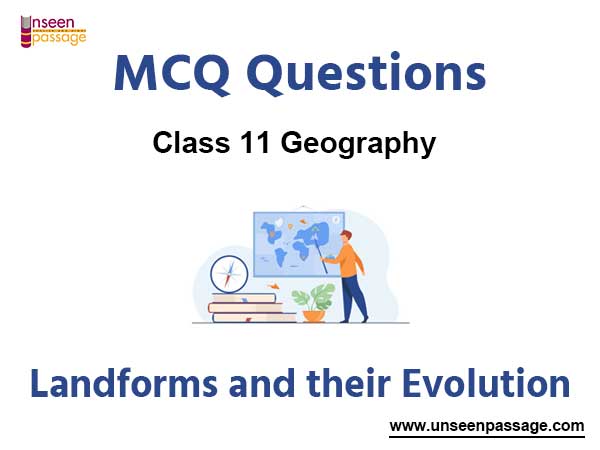Landforms and their Evolution MCQs Class 11 Geography
Please refer to Chapter 7 Landforms and their Evolution MCQs Class 11 Geography with answers below. These multiple-choice questions have been prepared based on the latest NCERT book for Class 11 Geography. Students should refer to MCQ Questions for Class 11 Geography with Answers to score more marks in Grade 12 Geography exams. Students should read the chapter Landforms and their Evolution and then attempt the following objective questions.
MCQ Questions Class 11 Geography Chapter 7 Landforms and their Evolution
Landforms and their Evolution MCQ Class 11 Geography provided below covers all important topics given in this chapter. These MCQs will help you to properly prepare for exams.
Question. Where is the largest canyon of the world present?
a. in U.S.A.
b. in Australia
c. in India
d. in China
Answer
A
Question. Deflation and abrasion activities are associated with
a. waves
b. rivers
c. winds
d. glaciers
Answer
C
Question. In which type of rocks the action of carbonation occurs?
a. sand rock
b. granite
c. limestone
d. none of these
Answer
C
Question. The stream action in combination with weathering, mass wasting and overhead flow is responsible for total process known as
a. flords
b. fiords
c. fluvial denudation
d. denudation
Answer
D
Question. The total number of wings a seif has is
a. one
b. three
c. five
d. six
Answer
A
Question. Name the process under which the rocks are decayed and decomposed without any change in their situation :
a. weathering
b. volcanisation
c. mass wasting
d. wave currents
Answer
A
Question. Erosional landforms are the
a. levees
b. deltas
c. braided channels
d. river terraces
Answer
D
Question. Name the geomorphologists who considered that landforms were the best indicators of earth’s history’:
a. S.W. Woolridge
b. M.M. Davis
c. both
d. none of these
Answer
C
Question. In the middle stages, erosion of valley sides is
a. vertical.
b. lateral.
c. gradual.
d. negligible.
Answer
B
Question. A deep valley characterised by steep step-like side slopes is known as?
a. U-shaped valley
b. Gorge
c. Blind valley
d. Canyon
Answer
D
Question. A land mass passes how many stages of development?
a. youth
b. mature
c. old age
d. all of them
Answer
D
Question. Which one of the following sentences best defines the term ‘Lapies’?
a. A small to medium sized shallow depression
b. A landform whose opening is more or less circular at the top and funnel shaped towards bottom
c. A landform formed due to dripping water from surface
d. An irregular surface with sharp pinnacles, grooves and ridges.
Answer
A
Question. What do we call the steep slope facing the sea?
a. canyon
b. coast
c. mountain
d. cliff
Answer
D
Question. Which of the following is a type of channel pattern?
a. Floodplains
b. Deltas
c. Meander
d. Alluvial Fans
Answer
C
Question. Name the landform that appears when soft rocks lie under the layer of hard rocks
a. gorge
b. canyon
c. zeugens
d. yardangs
Answer
C
Question. Erosion causes
a. Changes.
b. No change.
c. Upliftment.
d. Construction of land.
Answer
A
Question. In the middle stages, erosion of valley sides is
a. vertical
b. lateral
c. gradual
d. negligible
Answer
B
Question. Which one is a geomorphic agent?
a. running water
b. ground water
c. waves
d. all of them
Answer
D
Question. Natural levees and point bars are a depositional landform of
a. glaciers
b. waves
c. winds
d. rivers
Answer
D
Question. The stream action in combination with weathering, mass wasting and overhead flow is responsible for total process known as
a. flords
b. fiords
c. fluvial denudation
d. denudation
Answer
C

